Taking the Mystery Out of Retirement Planning
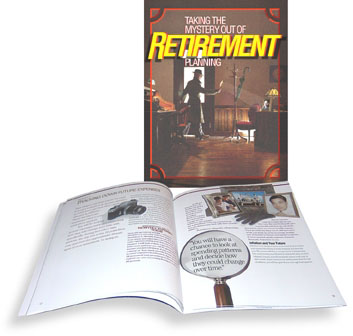
Printer Friendly Version | en español
Table Of Contents
- Chapter 1 - Tracking Down Today's Money
- Chapter 2 - Tracking Down Future Money...At Retirement and After
- Chapter 3 - Tracking Down Future Expenses
- Chapter 4 - Comparing Income And Expenses
- Chapter 5 - Five Ways To Close The Gap
- Chapter 6 - Making Your Money Last
- Chapter 7 - Tracking Down Help For Retirement
- Resources
This online version of Taking The Mystery Out Of Retirement Planning includes interactive worksheets that you complete as you read each chapter. You can download the fully illustrated 62-page Adobe PDF narrative or call toll free 1.866.444.3272 to order copies.
Planning For A Lifetime
It's not going to be your parents' retirement - rewarded at 65 with a gold watch, a guaranteed pension, and health insurance for life. For many Americans, retiring in this new century is a mystery. Earlier generations of workers could rely on employer-provided pensions, but now many workers will need to rely on their own work-related and personal savings plus Social Security benefits. These savings have to last longer because Americans are living longer, often into their eighties and nineties.
If you are one of those people who want to plan - and are about 10 to 15 years from the day you retire - this booklet is for you. Today's (and tomorrow's) retirees may well have a new kind of retirement. With a longer and healthier life span, bikes, boats, planes, and RVs may be part of your life, because you are more likely than previous generations to be an active older American.
Opportunities to take courses, start a new career, and become a volunteer can make your future an adventure. A longer life, however, will also mean more medical care, some of which will not be covered by the federal Medicare program.
 The whole retirement scene has changed and many American workers find it a mystery. In fact, a 2011 survey by the Employee Benefit Research Institute (EBRI) suggests that only 42 percent of Americans have tried to calculate how much they need to save for retirement. In this booklet, each chapter will give you clues on how to take control of your finances so that when you retire, you have the time and money to do what you've always wanted. For some, it's simply being with friends and family. For others, it's starting a new hobby or craft. And for some it's starting a new life.
The whole retirement scene has changed and many American workers find it a mystery. In fact, a 2011 survey by the Employee Benefit Research Institute (EBRI) suggests that only 42 percent of Americans have tried to calculate how much they need to save for retirement. In this booklet, each chapter will give you clues on how to take control of your finances so that when you retire, you have the time and money to do what you've always wanted. For some, it's simply being with friends and family. For others, it's starting a new hobby or craft. And for some it's starting a new life.
Whether you are 10 years from retirement or have a different timeframe - or even if you are retired - this booklet will help you to unravel the financial mysteries of life after work and to discover changes you can make for a financially secure future.
Time On Your Side
Getting started today will help you put time on your side. To help, Taking the Mystery Out of Retirement Planning offers a simplified, bottom-line approach to figuring out just how much you may need when you retire. The worksheets in this booklet will provide a guesstimate. Regard them as a starting point.
Each chapter in this booklet asks you to chart a different part of your financial life - your savings and your expenses - and helps you project future costs and savings well into your retirement years. Of course, no one has a crystal ball, and life has a way of throwing changes our way. But getting time on your side now, before you retire, means you will not be awake at 3 a.m. worrying about, instead of planning for, the future.
How To Use This Booklet: Simply read it to get familiar with retirement issues. Better yet, fill out the worksheets to figure the dollar amounts of what you have, how much it will grow in 10 to 15 years, and how much you may need to last over a 30-year period. Remember these amounts are only estimates, and you will want to update them from time to time.
 Take your time. You may want to tackle one or two chapters, fill out the worksheets provided...then spend some time gathering the documents and information you will want to keep. This online version of the booklet allows you to save the information that you have entered so you can find it when you return another day. Whether you approach the booklet chapter by chapter or all at once, keep going. Don't get stuck on details - guessing is okay, and you can always come back later with more accurate numbers and information.
Take your time. You may want to tackle one or two chapters, fill out the worksheets provided...then spend some time gathering the documents and information you will want to keep. This online version of the booklet allows you to save the information that you have entered so you can find it when you return another day. Whether you approach the booklet chapter by chapter or all at once, keep going. Don't get stuck on details - guessing is okay, and you can always come back later with more accurate numbers and information.
This booklet uses three time periods in charting your retirement savings. The starting point is today, when you are about 50 to 56 years old and plan to work approximately 10 to 15 years more. This is a good time to take stock of where you are in terms of retirement savings and set financial goals you would like to achieve in the 10 to 15-year period you plan to work.
 The second point in time is the day you retire, when you are about 65 to 66 years old. That period between now and then is an important one. In those (approximately 10 to 15) years, you will have time to put more of your paycheck to work in a retirement account. It will grow, not only from your additional savings, but also from the “miracle of compounding,” the world's greatest math discovery, according to everyone's favorite genius, Albert Einstein. This is the result of earnings from interest and from investments continually increasing the base amount.
The second point in time is the day you retire, when you are about 65 to 66 years old. That period between now and then is an important one. In those (approximately 10 to 15) years, you will have time to put more of your paycheck to work in a retirement account. It will grow, not only from your additional savings, but also from the “miracle of compounding,” the world's greatest math discovery, according to everyone's favorite genius, Albert Einstein. This is the result of earnings from interest and from investments continually increasing the base amount.
Finally, the third time period used in this booklet is the approximately 30-year span you hope to enjoy retirement. It is the time period experts suggest you plan for, based on the average 65-year old American male living 17 more years and the average 65-year old female living 20 more years. These are only averages, so planning for 30 years will help you avoid outliving your income.
As you read through this booklet, keep an eye on the Timeline for Retirement that follows. Some of the terms, like "catch-up" retirement contributions beginning at age 50, may be new to you. The timeline offers some milestone opportunities to make changes so you can have the kind of retirement you want. The time to start is today.
The General Information Worksheet will get you started thinking about when you will retire. This information will be used in the worksheets that follow to help you come up with your retirement savings.
|
||||||||||||||||
 Chapter 1 - Tracking Down Today's Money
Chapter 1 - Tracking Down Today's Money
This chapter will help you shine a light on the mystery of where you will find the money to support yourself in retirement. Many people don't have a clear idea of how much money they actually have, so it's hard to know how much they might be able to count on when they no longer work. Finding out what part of today's money can go toward retirement simply means adding up the value of all your current assets. In this case, "assets" are cash, investments, and anything of value you can exchange for cash, like your house, savings bonds, or even fine jewelry. This figure will be your first important clue.
 Recording these amounts could be a pleasant surprise. You don't want to count emergency money and savings for your children's education or a big trip - only money that you are not going to touch for at least 10 to 15 years. For purposes of the Pre-Retirement Assets/Savings Worksheet, you also don't want to include any future Social Security benefits and guaranteed pensions because these items are future income, not current assets (and they will be included later). Money in work-related retirement plans, like 401(k) plans, is counted, however, and you will want to include amounts from current and former jobs. In fact, these will probably be at the top of your list of today's assets that follows.
Recording these amounts could be a pleasant surprise. You don't want to count emergency money and savings for your children's education or a big trip - only money that you are not going to touch for at least 10 to 15 years. For purposes of the Pre-Retirement Assets/Savings Worksheet, you also don't want to include any future Social Security benefits and guaranteed pensions because these items are future income, not current assets (and they will be included later). Money in work-related retirement plans, like 401(k) plans, is counted, however, and you will want to include amounts from current and former jobs. In fact, these will probably be at the top of your list of today's assets that follows.
More Than You Think
Tracking your money in retirement plans should be fairly easy. If you didn't roll over your retirement plan balance when you changed jobs into a new retirement plan account or into an IRA, or if you didn't take your account balance as cash, you may discover some forgotten retirement assets you have. This is a good time to think about keeping your money with fewer, rather than more, quality financial institutions so it is easier to manage.
Recording current and old retirement account amounts on the Pre-Retirement Savings/Assets Worksheet, is important for a couple of reasons. First, locating an old account could take time. The longer it's "lost," the harder it will be to find. Second, understanding your current financial standing should automatically start you thinking about how to make your money grow.
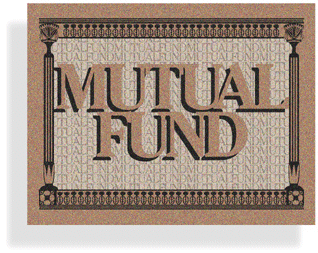
Quit Worrying, Start Planning
Remember you're facing a retirement that's probably going to be longer than your parents' and will involve more uncertainties. This new kind of retirement probably means there are many American workers worrying about, instead of planning for, the future.
You can choose to stop worrying and start figuring. Not only will you come up with facts to work with, the chances are good you might change the way you save. The 2011 EBRI survey also found that 44 percent of people who tried to figure out their financial futures ended up changing their retirement savings plans.
If you are a married woman: In preparing for retirement, women face the very real possibility of spending part of their retirement years without the support of a husband - most likely through widowhood. The loss of a spouse can sometimes mean the loss or reduction of benefits that can place women in financial jeopardy. For that reason, women will need to focus on their financial resources as a single person as well as half of a couple.
For purposes of the following worksheets, consider filling them out as a couple and as a single person. Consider what happens to your Social Security and to retirement benefits if your spouse dies or you divorce. Know what assets you can count on. Check Social Security benefit documents, retirement plan documents, and wills. Remember that wills are important, but they may not provide the protection desired. Depending on the way assets are titled or the terms of a will, the money women believe they can count on may not be passed to the surviving spouse.
 Next, you can estimate how much that money could be worth because it will probably grow - in the 10 to 15 years between now and retirement. The Pre-Retirement Assets/Savings Worksheet will help you project a 10 to 15-year total, which will help you estimate a 30-year total. Yes, it's just a guesstimate, because the further in the future you plan, the more that can happen. But the totals give you some idea of how much you may have for your retirement years. (People who are retired may want to skip this worksheet and focus on the information about ways to grow your money.)
Next, you can estimate how much that money could be worth because it will probably grow - in the 10 to 15 years between now and retirement. The Pre-Retirement Assets/Savings Worksheet will help you project a 10 to 15-year total, which will help you estimate a 30-year total. Yes, it's just a guesstimate, because the further in the future you plan, the more that can happen. But the totals give you some idea of how much you may have for your retirement years. (People who are retired may want to skip this worksheet and focus on the information about ways to grow your money.)
In addition, this worksheet will let you see how much your money can grow by investing it in different ways. In fact, you will be able to assign different rates of return to different types of savings and to see how your decisions can impact the growth of your money over the next 10 to 15 years. Rates of return are simply the amount your money earns over a certain period.
How your money increases over time will depend on the nature of your investments, the rates of return, and other factors, such as the economy. One kind of investment, for instance, is a bond, which is often referred to as a "fixed income" investment because the interest rate is fixed. As an example, if you owned a bond with an original value of $10,000 and you got a 5 percent return (or yield) on your investment, your original investment would increase to $16,289 in 10 years.
Digging Deeper
 You will probably want to dig deeper by assigning different rates of return to different pots of money-workplace savings accounts, IRAs, bank savings accounts-you have put aside for retirement. Let's say you have $2,000 in a checking account that you never use. Your rate of return, in this case, with interest compounded monthly, will be low, maybe 1 percent. But your money is safe. Then let's say you've invested in a stock mutual fund for 15 years using your retirement plan account and you get a return of 9 percent. Investments in securities can bring a higher rate of return than simple interest because prices of securities often rise and gains are compounded. Of course, security prices can fall, as we saw with stocks in 2000, 2001, and 2008. The tradeoff for aiming for higher returns is taking on more risk, including the risk of losing money. Keep this in mind in selecting rates of return for the Pre-Retirement Savings/Assets Worksheet.
You will probably want to dig deeper by assigning different rates of return to different pots of money-workplace savings accounts, IRAs, bank savings accounts-you have put aside for retirement. Let's say you have $2,000 in a checking account that you never use. Your rate of return, in this case, with interest compounded monthly, will be low, maybe 1 percent. But your money is safe. Then let's say you've invested in a stock mutual fund for 15 years using your retirement plan account and you get a return of 9 percent. Investments in securities can bring a higher rate of return than simple interest because prices of securities often rise and gains are compounded. Of course, security prices can fall, as we saw with stocks in 2000, 2001, and 2008. The tradeoff for aiming for higher returns is taking on more risk, including the risk of losing money. Keep this in mind in selecting rates of return for the Pre-Retirement Savings/Assets Worksheet.
 In the example above, with some money invested in stocks and some in a safer, interest-bearing account, you are already doing what the experts recommend. You are practicing "asset allocation" - by putting your money in different types of products that earn different rates of return. Financial planners highly recommend this technique as a way to spread risk. A general allocation is to have some money in "cash," such as a savings, checking, or money market account with little or no risk; some money in bonds, with a little more risk but paying more interest; and some money in stocks, with more risk but a likely higher return, especially in the long run.
In the example above, with some money invested in stocks and some in a safer, interest-bearing account, you are already doing what the experts recommend. You are practicing "asset allocation" - by putting your money in different types of products that earn different rates of return. Financial planners highly recommend this technique as a way to spread risk. A general allocation is to have some money in "cash," such as a savings, checking, or money market account with little or no risk; some money in bonds, with a little more risk but paying more interest; and some money in stocks, with more risk but a likely higher return, especially in the long run.
 Another way to spread your investments among different categories is to invest in index mutual funds. Index funds are a collection of investments, such as bonds or stocks, that closely match the performance of the major holdings for that category of investment. For instance, a Standard and Poor's (S&P) index fund tracks the 500 broad-based stocks that comprise the S&P 500 Index. A bond index fund would track the performance of major bond holdings in that index. In this way, your investment is following the financial market for that particular category.
Another way to spread your investments among different categories is to invest in index mutual funds. Index funds are a collection of investments, such as bonds or stocks, that closely match the performance of the major holdings for that category of investment. For instance, a Standard and Poor's (S&P) index fund tracks the 500 broad-based stocks that comprise the S&P 500 Index. A bond index fund would track the performance of major bond holdings in that index. In this way, your investment is following the financial market for that particular category.
Experts recommend that you spread your money among a range of investments so that your money is "diversified." In addition, most experts add that you should not only invest among categories but within each major category as well. For instance, your risk of losing money is less if you buy shares in several mutual funds investing in various types of assets (such as large company stocks, small company stocks and bonds). Even investing in just one mutual fund will help you to diversify compared to investing in individual securities on your own, since mutual funds, by their nature, allow you to invest in a collection of stocks, bonds, etc.
Financial planners believe that diversifying your investments helps reduce risk as markets move up and down. For example, in 1980 when some certificates of deposit (CDs) were paying 12 percent, stocks were barely holding their own; but in 1999 most stock prices were rising fast, and CDs were paying 5 percent. You will see sample rates of return for some common places to put your money in the box below.
Too much money in one type of investment is always a bad idea and puts your money at risk. For example, many American workers are holding a lot of their employers' stock in their retirement accounts. This ties both your current paycheck and your retirement savings to one employer's success...or failure. This can be risky.
Now that you have tracked down your retirement savings, personal savings, and other assets and investments, you can return to the worksheets, and select the tab to fill out the Pre-Retirement Savings/Assets Worksheet.
Chapter 2 - Tracking Down Future Money...At Retirement And After
|
Congratulations. You are making great progress in tracking down your retirement assets and solving the first half of your retirement mystery. Now move on to the Post-Retirement Assets/Savings Worksheet to come up with a monthly income during retirement. Based on the information you entered in the Pre-Retirement Assets/Savings Worksheet and what you enter in this worksheet, you will have a monthly income that can then be compared to your anticipated monthly expenses in retirement.
Return to the worksheets, and select the tab for the Post Retirement Assets/Savings Worksheet. You can now add Social Security and pension benefits as this worksheet deals with income you can rely on during retirement.
Chapter 3 - Tracking Down Future Expenses
 This chapter will start you on the road toward a realistic look at your expenses in retirement and how they will be affected by inflation. These numbers are important clues to your retirement mystery.
This chapter will start you on the road toward a realistic look at your expenses in retirement and how they will be affected by inflation. These numbers are important clues to your retirement mystery.
You will be looking at your expenses today and estimating how they will change over time and, specifically, during two other time periods: the day you retire 10 to 15 years from now, and over the approximate 30-year span of your retirement. In doing so, you will have some idea of whether the money you have saved will be enough to last. You will also have a chance to look at your spending patterns and decide how they could change over time. After all, you can't control inflation over this stretch of time, but you certainly can control what you spend.
 Your expenses will likely change as you grow older. Early on, you will spend less on work-related things like transportation and clothing. Maybe you'll spend more on traveling, hobbies, or other things you have always wanted to do. As you age, it is likely that more of your budget will go toward medical expenses, which you will read about soon. Retired people may find that recording their expenses will alter future spending patterns.
Your expenses will likely change as you grow older. Early on, you will spend less on work-related things like transportation and clothing. Maybe you'll spend more on traveling, hobbies, or other things you have always wanted to do. As you age, it is likely that more of your budget will go toward medical expenses, which you will read about soon. Retired people may find that recording their expenses will alter future spending patterns.
Inflation And Your Future
Inflation, in its simplest terms, means that dollar for dollar your money will not buy as much next year as it does this year. This means inflation is a major factor in determining how much money you will need in retirement since, to cover inflation’s impact, you will need more money every year. In other words, if your money is not earning more than the rate of inflation, you will lose part of your nest egg’s buying power.
You can't know and can't control future inflation. The only accurate inflation rates are from the past, and they vary widely. In 1980, overall prices went up a whopping 13.5 percent; in 2002, they went up only 1.6 percent. Looking at the past shows how rates may vary widely.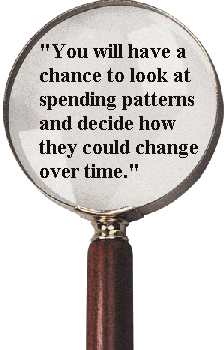 The Expenses Worksheet assumes a 3.5 percent rise in prices for the next 10 to 15 years. But these are estimates, and remember, we've gotten used to low inflation overall - with a few glaring exceptions - over the last decade.
The Expenses Worksheet assumes a 3.5 percent rise in prices for the next 10 to 15 years. But these are estimates, and remember, we've gotten used to low inflation overall - with a few glaring exceptions - over the last decade.
Facing Down Rising Costs
One exception to low inflation rates is medical costs, which have risen faster than inflation over the last 20 years and some experts think will rise about 7 percent a year over the coming years. If you have, or your family history includes, a serious medical condition like heart disease, you will probably spend more on health care than you ever imagined. According to recent studies, almost 20 percent of retiree income will be spent on health care.
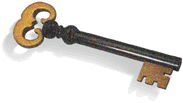 While Medicare is a great benefit to persons 65 and older, it does not cover all medical costs - deductibles, co-payments, and long-term care, for example. Medicare Part A covers hospital care only. Medicare Part B, an additional insurance you will be offered when you become 65, covers doctors' services, outpatient hospital care, and things like physical and occupational therapy and some home health care. The current cost of Medicare Part B is about $100 per month for most people, although some may pay more. In addition to Medicare Parts A and B, many retirees buy Medigap policies for uncovered services like dental and vision care and drugs. Depending upon where you live and the policy you choose, you can pay from well under $100 to as much as $350 a month. Medicare, private insurance, and/or Medicaid pay for only about 85 percent of retirees’ overall health care expenses.
While Medicare is a great benefit to persons 65 and older, it does not cover all medical costs - deductibles, co-payments, and long-term care, for example. Medicare Part A covers hospital care only. Medicare Part B, an additional insurance you will be offered when you become 65, covers doctors' services, outpatient hospital care, and things like physical and occupational therapy and some home health care. The current cost of Medicare Part B is about $100 per month for most people, although some may pay more. In addition to Medicare Parts A and B, many retirees buy Medigap policies for uncovered services like dental and vision care and drugs. Depending upon where you live and the policy you choose, you can pay from well under $100 to as much as $350 a month. Medicare, private insurance, and/or Medicaid pay for only about 85 percent of retirees’ overall health care expenses.
Medicare also has a Part C, which serves as an alternative to traditional Part A and Part B coverage. Under this option, beneficiaries can choose to enroll in and receive care from private “Medicare Advantage” and certain other health insurance plans that contract with Medicare. In most of these plans, there are extra benefits and lower premiums than the original Medicare plan, however your choice of doctors and hospitals may be limited, and the plans' copayments and charges may vary. You do not need to purchase a Medigap policy if you join a Medicare Advantage Plan.
 An additional feature is the Medicare prescription drug program (Medicare Part D). Those who become eligible for Medicare Part A and/or Part B can join a prescription drug plan offered in their area. By paying a small premium - around $30 a month in 2012 - those who join will be able to get prescription drugs at a lower cost. (The Resources section includes booklets about this program.)
An additional feature is the Medicare prescription drug program (Medicare Part D). Those who become eligible for Medicare Part A and/or Part B can join a prescription drug plan offered in their area. By paying a small premium - around $30 a month in 2012 - those who join will be able to get prescription drugs at a lower cost. (The Resources section includes booklets about this program.)
If you are thinking about retiring early, you may have to buy health insurance until Medicare kicks in at age 65 if your employer does not cover health care for retirees. You should know that employer-provided health benefits for retirees might not be guaranteed, and could be reduced or eliminated by your former employer under some circumstances.
Where Will You Live When You Retire?
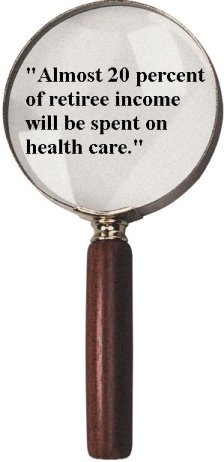 Make planning for your future housing needs one of your first priorities since where you live in retirement affects not only your income, but also your emotional, social, and physical well being. It is an important part of your overall retirement strategy. While the cost of owning a home hasn't gone up as much as health care, it is high in many regions. Home heating and cooling costs are rising fast too. Maintenance, condo fees, real estate taxes, and insurance are other costs affected by inflation.
Make planning for your future housing needs one of your first priorities since where you live in retirement affects not only your income, but also your emotional, social, and physical well being. It is an important part of your overall retirement strategy. While the cost of owning a home hasn't gone up as much as health care, it is high in many regions. Home heating and cooling costs are rising fast too. Maintenance, condo fees, real estate taxes, and insurance are other costs affected by inflation.
As you age, you may want to look into other types of housing. Independent living retirement communities, designed for reasonably healthy older people, often require a large down payment, for example $120,000, and then a monthly fee of $2,000 or more. Saving for nursing home care, which in 2009 averaged $219 a day, also might make you feel more financially secure, given that at least 40 percent of today's 65-year-old Americans will spend some time in the future in a nursing home.
With medical and housing costs such a big part of a retirement budget, it's no surprise that products and services have been developed to help plan for and manage these costs. 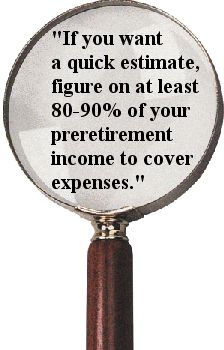 Rising health care costs, in particular, could consume all the money saved for retirement. Long-term care insurance can protect retirees' assets by paying for medical care in a nursing home and sometimes in your own home. Premiums vary by the features you choose, such as the amount of the daily benefit paid and protection against inflation. The average premiums for a 60-year old are about $2,300. Buying such a policy at a later age means higher premiums. If you're considering a policy, get some advice, because long-term care insurance is a new product and some policyholders may find the coverage isn't what they need.
Rising health care costs, in particular, could consume all the money saved for retirement. Long-term care insurance can protect retirees' assets by paying for medical care in a nursing home and sometimes in your own home. Premiums vary by the features you choose, such as the amount of the daily benefit paid and protection against inflation. The average premiums for a 60-year old are about $2,300. Buying such a policy at a later age means higher premiums. If you're considering a policy, get some advice, because long-term care insurance is a new product and some policyholders may find the coverage isn't what they need.
To cope with these future expenses, some preretirees are starting special health care savings funds at work, separate from their retirement savings. One example is a type of account, a health savings account (HSA), which is designed to help certain employees save for future qualified medical and retiree health expenses on a tax-free basis. Essentially, an HSA is a savings account into which you can deposit money for future use. If you belong to a health plan with a deductible of at least $1,200 (for individual coverage) or $2,400 (for family coverage), you may be able to set up an HSA. Individuals who don’t belong to a workplace health plan can sign up for HSAs with some banks, insurance companies, and other approved entities.
These accounts can receive contributions from you, your employer, or even a family member on your behalf. You can use the funds from an HSA to help offset future medical costs, and the money in your account can be carried over from year to year. In addition, this type of account is portable; it stays with you as you move from one employer to another or if you leave the work force. To learn more about health savings account criteria, see the Resources section. Returning to the worksheets, now select the tab for the Expenses Worksheet and start entering what you are spending today and what your expenses will be at retirement.
Chapter 4 - Comparing Income And Expenses
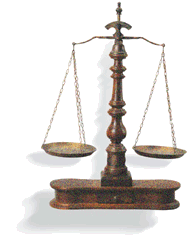 Now you will compare your income with your expenses during retirement and see if they match up. This is the number you've been working toward as you've investigated your assets and income, then expenses, and finally, figured the effects of time on your money. By the end of Chapter 4, you will discover whether you need to save more for retirement and, if so, how much more...and you will learn how to grow your savings over time.
Now you will compare your income with your expenses during retirement and see if they match up. This is the number you've been working toward as you've investigated your assets and income, then expenses, and finally, figured the effects of time on your money. By the end of Chapter 4, you will discover whether you need to save more for retirement and, if so, how much more...and you will learn how to grow your savings over time.
Few people will have exactly the amount of money they will need in retirement. Most will get a negative figure - a gap - when they do the math. If this is your situation, this chapter can help you figure how much more to save each month over the next 10 to 15 years until you retire. After you come up with your totals, be sure to read on to find out the difference a year can make and the five ways to close the gap and boost your savings. Where will you find additional savings? Here are some suggestions for active workers and retirees alike.
You probably know by now the easiest way to watch your nest egg grow is to make the maximum contribution to your workplace savings plan through payroll deductions. If you are 50 or over, you will have the chance to add even more to your savings through catch-up contributions, ranging from $1,000 to $5,500, depending on the type of retirement plan you have. And you are reducing your taxes. If there's no retirement plan at work, you can add annual contributions to any IRA accounts you have.
 Join The Club
Join The Club
Most people haven't thought about how long their savings will last in retirement or how much inflation will increase over time.
The Projections and Results Worksheet is where all your prior work comes together. Building on the clues uncovered in the earlier worksheets, this worksheet compares your anticipated income and expenses over the 30 years of your retirement. Making the comparison in dollars valued at the time of your retirement, this worksheet takes into account that while you will have a fixed monthly income, your expenses will increase due to inflation.
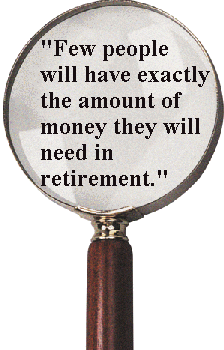 At the beginning of retirement, most people's monthly income likely will exceed their expenses; but after a decade or so, expenses begin to exceed the monthly income. Realizing this now will allow you to save and invest any extra income in the early years of retirement so that it will grow and can be used to cover increased expenses later in retirement. Especially if you have a shortfall, the Projections and Expenses Worksheet will allow you to see how much you may need to add to your savings. When doing this comparison of your projected income and expenses, keep in mind that the value of a dollar tomorrow is less than a dollar today. The goal is to stay ahead of inflation. For example, a dollar today is worth more than a dollar in 30 years if the rate of return, say 5 percent, is greater than the inflation rate, say 3.5 percent. The worksheet addresses the impact of inflation by converting your anticipated cash flows into a constant dollar value - at the time of your retirement.
At the beginning of retirement, most people's monthly income likely will exceed their expenses; but after a decade or so, expenses begin to exceed the monthly income. Realizing this now will allow you to save and invest any extra income in the early years of retirement so that it will grow and can be used to cover increased expenses later in retirement. Especially if you have a shortfall, the Projections and Expenses Worksheet will allow you to see how much you may need to add to your savings. When doing this comparison of your projected income and expenses, keep in mind that the value of a dollar tomorrow is less than a dollar today. The goal is to stay ahead of inflation. For example, a dollar today is worth more than a dollar in 30 years if the rate of return, say 5 percent, is greater than the inflation rate, say 3.5 percent. The worksheet addresses the impact of inflation by converting your anticipated cash flows into a constant dollar value - at the time of your retirement.
If the result is negative, don't worry. Just about everyone will need to make up a shortfall in savings. Remember also, that it is difficult to project inflation rates, especially for health care, that far in the future. It is better, however, to have a rough idea of where you stand than have no guesstimate at all.
The good news is that time is on your side. Remember the effect of interest compounding and how it can work to make your money grow in 10 years. Each year, as you set aside more money, the combination of savings and earnings will help close the gap. Return again to the worksheets and select the Projections and Results Worksheet. This worksheet lets you figure out how much you need to start to save today to make up the gap between projected income and expenses.
 Socking away that amount of money over the next 10 to 15 years, while getting a rate of return you're comfortable with, should go a long way toward matching up income and expenses over 30 years of retirement.
Socking away that amount of money over the next 10 to 15 years, while getting a rate of return you're comfortable with, should go a long way toward matching up income and expenses over 30 years of retirement.
You don't have to save the total amount of any gap between what you have and what you need. Each year the amount you invest will grow, and the growth of your savings lessens the amount you need to save.
Chapter 5 - Five Ways To Close The Gap
Where will you find additional savings? Here are some suggestions for workers and retirees alike.
Number 1: Work your contributions at work - Without exception, retirement planners advise contributing the maximum to your retirement plan, especially if your employer contributes too. If your contributions are made by salary deduction, saving is easier to do and may seem almost painless. And contributing more means postponing, or "deferring," taxes until you withdraw the money at retirement. Then you may be in a lower tax bracket.
Catch-up provisions for some retirement plans allow you to contribute extra amounts if you're over 50. Information about 401(k) catch-up contributions is available from your retirement plan administrator or on the Internet. If your plan has a catch-up provision, act on it now.
Number 2: Work longer, retire later - Staying employed as long as possible benefits your retirement finances in several ways. Having an income gives your retirement savings more time to grow. A regular income could mean more regular savings. If you work for a company that provides health insurance, you won't have to fully pay for a policy yourself.
You don't have to stay at your same job if there are other opportunities. Maybe you want a new career, one that ties in to your personal interests. Longer life spans and better health mean many older people have the energy and enthusiasm employers are looking for, not to mention the skills and experience. Many people find the social benefits of working as important as the financial ones.
|
Number 3: Cut expenses, big and little - Moving to a region with lower housing and living costs or moving to a smaller home can help narrow the savings gap. Another option is staying in your community but downsizing to a smaller place like a condo or apartment. The same factors that drove up the value of your current house, however, will also have driven up overall housing costs, including real estate taxes. Housing is a major part of everyone's budget so think carefully about where you want to be and whether you can afford it. Keep in mind, however, that moving includes its own financial expenses and means leaving friends and your community.
Financial planners say that pre-retirement years are the wrong time to take on large debts, including home equity loans and credit card debt, with its high interest rates. Buying a new car, boat, or vacation home is not wise if you need to save. Investing that $400 a month (the average 5-year car loan payment) and getting a 5 percent return would put more than $27,000 in your retirement account. Consider keeping your old car or buying a used one.
Pre-retirement is also the wrong time to give or "loan" large sums of money to your children and grandchildren. Their earning power is usually far better than yours. Now is the time to take care of your finances so you don't have to ask others to bear the financial burden for your care later on.
Number 4: Social Security, now or later? - The amount of your monthly Social Security benefit goes up the older you are when you start receiving it. For example, a 61-year-old man earning $60,000 in 2011 and eligible for his Social Security benefit at 62 would receive an additional $1,068 a year by waiting 1 year, until he is 63, to collect his benefits. On the other hand, retirees who are seriously ill, who need the money immediately, or who feel comfortable investing their monthly checks may choose not to wait.
In this example, the worker turning 62 in 2012 would have a full retirement age under Social Security of 66. At full retirement, his benefit will be $1,644. If, however, he starts to receive benefits at age 62, his monthly benefit would be reduced to $1,171. By waiting until age 70, his monthly benefit would be $2,280.
On average, early retirement will give you about the same total Social Security benefits over your lifetime, but in smaller amounts to take into account the longer period you will be receiving them.
|
||||||||||||||||||||||||||||||||||||||||||||||||||||||||||||||||
If you delay retirement beyond the full Social Security retirement age, you can earn retirement credits, increasing Social Security by a certain percentage (depending on date of birth) until you reach age 70.
Regardless of the age you start receiving Social Security benefits, remember to sign up for Medicare at age 65. If you don't (for example, because you have other coverage) you may be limited on when you can enroll later and may pay more in premiums. For more information, see the Resources section.
Number 5: Put your money where the returns are - Educate yourself about investing and consider paying a professional to help you choose the right place for your money. Financial experts say too many people keep too much money in the wrong kinds of accounts, for example checking accounts, savings accounts and money market funds, which typically have low interest or return rates. Review the discussion in Chapter 2 about asset allocation and diversification of investments.
Adding $200 a month, or $2,400 a year over 10 years to a starting retirement savings balance of $40,000 would more than double your money, assuming a 5 percent rate of return and all earnings reinvested.
Chapter 6 - Making Your Money Last
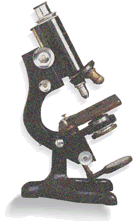 The point of all the calculations you have done in this booklet is to make sure your income will last a lifetime. If doing the worksheets has uncovered a gap between your retirement income and expenses, you probably will be changing some financial habits over the next 10 to 15 years. The only part of your retirement mystery that remains is deciding how you are going to make your retirement income last as long as you do. You will need a strategy.
The point of all the calculations you have done in this booklet is to make sure your income will last a lifetime. If doing the worksheets has uncovered a gap between your retirement income and expenses, you probably will be changing some financial habits over the next 10 to 15 years. The only part of your retirement mystery that remains is deciding how you are going to make your retirement income last as long as you do. You will need a strategy.
Solving your retirement mystery has revealed that more saving (especially for medical costs), more investing, and less spending will boost your confidence and your financial bottom line as you near the end of your working life.
For now, you will probably need to focus on adding to your nest egg and investing it wisely. Take into account that you will also have income taxes to pay. Take the short tax quiz in this chapter to find out about minimizing your taxes in retirement.
 You may also want to take a look at financial products and services that could help build some financial security into your retirement. But first, a word of caution. Because you're growing a nest egg, you may start hearing from people offering their own strategies for managing your retirement money. These people may be relatives and friends. You will also hear from strangers in phone calls, letters, and emails. Some may offer to double your money at no risk. Think long and hard about involving them in your financial affairs, unless they're qualified financial professionals and can be objective. Retirees are frequently targets for scams. Don't give out any personal information to strangers. Don't be a courtesy victim. Con artists will not hesitate to exploit your good manners. Save courtesy for friends and family members, not potential swindlers!
You may also want to take a look at financial products and services that could help build some financial security into your retirement. But first, a word of caution. Because you're growing a nest egg, you may start hearing from people offering their own strategies for managing your retirement money. These people may be relatives and friends. You will also hear from strangers in phone calls, letters, and emails. Some may offer to double your money at no risk. Think long and hard about involving them in your financial affairs, unless they're qualified financial professionals and can be objective. Retirees are frequently targets for scams. Don't give out any personal information to strangers. Don't be a courtesy victim. Con artists will not hesitate to exploit your good manners. Save courtesy for friends and family members, not potential swindlers!
It's A Big Deal
"Having a strategy" may sound like retirement is a battle or a complicated business opportunity. You may be thinking, "What's the big deal? I'll just withdraw money when I need to pay bills." Your parents may have done fine by simply cashing their monthly Social Security and pension checks to live on. Their taxes most likely were a lot simpler and a lot easier to do.
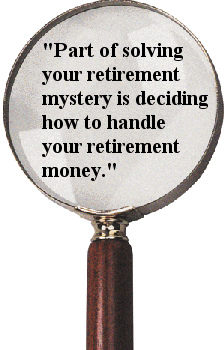 In today's world, keep in mind that the money you have saved and invested will be earning income until you withdraw it. Part of solving your retirement mystery will be deciding how to handle your retirement money, including continual investing, throughout your lifetime. Your tax situation, both federal and state, may not be so clear. You need to plan a withdrawal strategy so you pay less tax on money you take out of your retirement account and continue to grow the money you leave in. A qualified tax adviser can help here.
In today's world, keep in mind that the money you have saved and invested will be earning income until you withdraw it. Part of solving your retirement mystery will be deciding how to handle your retirement money, including continual investing, throughout your lifetime. Your tax situation, both federal and state, may not be so clear. You need to plan a withdrawal strategy so you pay less tax on money you take out of your retirement account and continue to grow the money you leave in. A qualified tax adviser can help here.
Getting Your Retirement Benefits
You may need to decide whether to take your pension or your retirement plan benefit in a lump sum or in an annuity. You can find out about your retirement plan payout options by reading your plan documents. Or you can contact the plan administrator directly for information about what your plan offers.
If you are in a traditional pension plan, your benefit is paid in the form of an annuity - that is, through periodic payments, typically monthly, for an extended period, usually your lifetime. 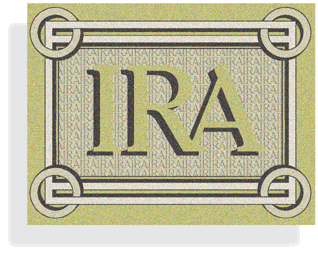 If you select an option that provides for a survivor benefit for your spouse, note that your monthly benefit will be reduced. The survivor benefit is typically 50 percent of the retiree's benefit, but some plans provide for other options, such as 75 percent.
If you select an option that provides for a survivor benefit for your spouse, note that your monthly benefit will be reduced. The survivor benefit is typically 50 percent of the retiree's benefit, but some plans provide for other options, such as 75 percent.
If you are in a defined contribution plan, such as a 401(k) plan, you do not automatically get your benefit as an annuity. Your retirement benefit can be taken as a lump sum paid entirely at the time of your retirement, or, as in some plans, through periodic payments over a short period of time, such as 3 or 5 years. Your plan may provide an annuity option or you may choose to buy an annuity with all or part of your lump sum benefit. If you choose to take your benefit in a lump sum, be sure to put it in a tax-deferred account, such as an IRA, within 60 days to avoid paying high income taxes (the highest tax being 35 percent as of 2011) on the amount. You will then have to decide how to invest what could be the most money you've ever accumulated and make sure it lasts for the 30 years of your retirement.
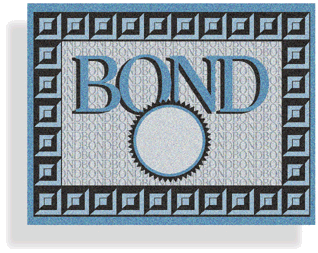 If you choose an annuity, make sure you realize the risks and rewards. An annuity provides a steady stream of income that lasts throughout your lifetime and can provide adjustments for inflation. This is helpful especially in the early years of retirement when there may be the temptation to spend the excess income instead of saving it to make sure it is there in 20 to 30 years. Keep in mind that if you die sooner than expected, however, the insurance company may keep the remaining balance unless you have opted for a survivor benefit. That is why annuities are usually not recommended for those with a shortened life span. Annuities come in many varieties. If you are purchasing one, choose an insurance company with a good credit rating and track record. Be sure you know what you're buying - there are costs involved in ending the contract. The more you learn upfront, the better.
If you choose an annuity, make sure you realize the risks and rewards. An annuity provides a steady stream of income that lasts throughout your lifetime and can provide adjustments for inflation. This is helpful especially in the early years of retirement when there may be the temptation to spend the excess income instead of saving it to make sure it is there in 20 to 30 years. Keep in mind that if you die sooner than expected, however, the insurance company may keep the remaining balance unless you have opted for a survivor benefit. That is why annuities are usually not recommended for those with a shortened life span. Annuities come in many varieties. If you are purchasing one, choose an insurance company with a good credit rating and track record. Be sure you know what you're buying - there are costs involved in ending the contract. The more you learn upfront, the better.
You can also buy an annuity with money from other assets such as an inheritance or the sale of your house. Like other annuities, you will receive a monthly check for a defined period or for life. The tax treatment of these payouts will be different, however. Like any investment, review the terms of the annuity before you purchase it. For example, will the amount paid vary based on investment returns or is it fixed, what will you pay in related fees, etc.
 Another way to make your money last is to obtain a reverse mortgage - essentially a bank loan based on the amount of the equity in your home. It can provide you with a monthly check, but at a cost. You are spending down the value of your home. If you can keep your house in good repair so the bank sees value in the loan, this is a way to supplement your income and not have to leave your home. When you or your heirs sell the house, however, the loan has to be repaid. Talk with the bank about any taxes due on these payments, and make your family aware of your reverse mortgage.
Another way to make your money last is to obtain a reverse mortgage - essentially a bank loan based on the amount of the equity in your home. It can provide you with a monthly check, but at a cost. You are spending down the value of your home. If you can keep your house in good repair so the bank sees value in the loan, this is a way to supplement your income and not have to leave your home. When you or your heirs sell the house, however, the loan has to be repaid. Talk with the bank about any taxes due on these payments, and make your family aware of your reverse mortgage.
Also, remember long term care insurance can help you plan for increased health care costs in your later years.
Withdrawals: Which Pot?
You probably have some personal savings included in your retirement nest egg that you've already paid taxes on. A Roth IRA, for example, is a good place to leave money you've invested for growth because the withdrawals are not taxed. Retirement experts say you usually should withdraw from this pot of money earlier in retirement when you may be in a higher income tax bracket. Withdraw your taxable retirement plan money (such as your 401(k) or other workplace savings plan) later, when you have less taxable income and possibly higher deductions due to medical expenses.
Be aware, however, that the IRS requires you to start withdrawing tax-deferred money from retirement accounts when you turn 70½ years of age. (This is a milestone on the Retirement Timeline at the beginning of this booklet.) By doing so, you will avoid tax penalties. These withdrawals are called " required minimum distributions," and the formula for determining the amount can be complicated. You may want to consult a tax expert for help.
Can You Beat It?
As you're withdrawing money to pay your bills in retirement, you should be trying to grow your remaining money to at least keep up with inflation. Of course, it's better to beat inflation. Experts say you need to continue investing and diversifying your assets throughout your life. Keeping your money in accounts paying guaranteed interest rates will keep it safe, but not from inflation. Inflation is a major threat to your financial future, so make it a consideration in your investment decisions.
Going It Alone vs. Getting Help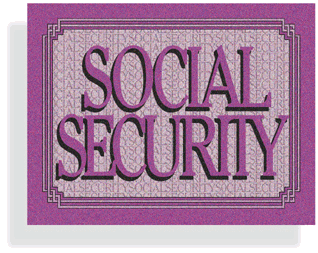
With a lot of study and regular attention to changes in tax laws, the economy, the stock market, and your money, you may be able to come up with a strategy to minimize taxes and maximize income. There's even software to help.
There's another road too. You can hire someone to develop your strategy and manage your money for you. Especially during the later years of your retirement, you may want to seek the help of a professional, when you may have less interest, energy, and ability to keep your strategy on target.
Good financial professionals, and the companies they work for and with, are required by law to be clear and open about their fees and charges and whether they are paid by commissions or for the sales of financial products, such as annuities and mutual funds. Be sure to ask questions, get references, and avoid anyone who guarantees performance on returns. This way you can make an informed decision. After all, it is your money you are putting in their hands. For more information, see the Resources section.
Taxes & Retirement - True Or False?
Income taxes go away when you're retired. True or False?
False. Remember all that pretax money you contributed to your retirement plan? When you withdraw it at retirement, you pay income taxes.
Social Security benefits are not sheltered from taxes. True or False?
True. A portion of your Social Security benefits is included in your taxable income if, for example, in 2011, you have taxable income and Social Security benefits of more than $25,000 for a single person and $32,000 for a couple.
There are no tax consequences if you don't start to withdraw your pretax savings at age 70½? True or False?
False. There is a 50 percent tax penalty on amounts that the IRS requires to be taken out after age 70½ and that are not withdrawn when required. In tax terms these are called "minimum required distributions.”
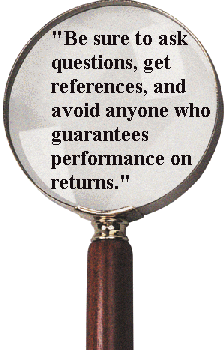 A Few Words About Scams
A Few Words About Scams
As you plan your retirement, don't let fear, desperation, or the need to catch up financially push you into any hasty investment decisions. In all legitimate investments, higher returns are accompanied by higher risks - risks you may well not want to take as you near retirement. Be wary of anyone who claims they can sell you a product that offers great reward without great risk - a sure sign of a scam. Here are a few points to keep in mind when you make any financial decision:
Recognize that anyone can claim to be a "financial consultant” or "investment counselor.” That person may not have the special training, expertise, or credentials necessary to back up the claim, however. Ask about licensing and professional designations and check them out with securities regulators and any trade groups in which they claim membership.
Understand your investments and never be afraid to ask questions. Good financial professionals are never pushy, and they never dismiss your concerns.
Don't let embarrassment or fear keep you from reporting suspected investment fraud or abuse. Contact the securities agency in your state as soon as you suspect a problem or believe you have been dealt with unfairly.
Never judge a person's integrity by how they sound or how they appear. The most successful con artists sound extremely professional and have the ability to make even the flimsiest investment seem as safe as putting money in the bank.
Monitor your investments. Ask tough questions and insist on speedy and satisfactory answers. Make sure you get regular written and oral reports. Look for signs of excessive or unauthorized trading of your funds when you receive statements, and do not be swayed by assurances that this kind of practice is routine.
Above all, become an informed investor. In investing, as in life, if it sounds too good to be true it probably is.
Now that you have reviewed the rewards and pitfalls of investing, you are ready for a review of all the clues you've tracked to solve the mystery of your retirement. Reading it will reinforce what you've learned and will help you to take action. You'll also find several resources to turn to for more information. Take advantage of them.
 Chapter 7 - Tracking Down Help For Retirement
Chapter 7 - Tracking Down Help For Retirement
Like a black and white TV, retirement used to have high contrast and few choices: One day you were working and the next day you weren't. One day you lived on a paycheck and the next day on pension and Social Security checks. Your income was fixed and retirement was no mystery.
You have the power to put some color, maybe even gold, in your retirement. It mostly means putting into action a plan to close the income-expense gap and manage your money smartly now and during your later years.
You won't be alone. In the next 25 years, one in five Americans will be over 65. That's a lot of people today who need to work on a clear and realistic retirement plan during the next 10 to 15 years. Make sure you're one of them so your retirement wishes come true.
In the following list, you will find ways to discover more clues about retiring gradually and maybe working longer, paying attention to your assets and income, saving and investing, planning for increased expenses, including medical costs, and developing a withdrawal strategy. The information available on the Websites listed is rich in detail and wide in scope. But remember to protect your privacy by not giving out personal information such as your Social Security number, telephone, or address, unless you know whom you're dealing with.
In fact, helping American workers succeed in a new kind of retirement has become the focus for a number of government agencies and organizations. Businesses selling products and services like annuities, long-term care insurance, and income management services are another source of information. To reach all these sources, use the Internet, your telephone, and the public library.
Periodically look back over the worksheets you have done and fill them out again as your finances change. Chart your progress through the next 10 to 15 years until retirement and beyond. Get time on your side and get going.
 Resources
Resources
This Booklet Is Presented By
U.S. Department of Labor
Employee Benefits Security Administration
200 Constitution Avenue, NW
Washington, DC 20210
Toll-free publication request line: 1.866.444.3272
North American Securities Administrators Association, Inc.
750 First Street, NE, Suite 1140
Washington, DC 20002
Tel. 202.737.0900
The Actuarial Foundation
475 North Martingale Road, #600
Schaumburg, IL 60173
Tel. 847.706.3535
We also thank AARP for its valuable contributions to this booklet. The following Websites, booklets, pamphlets, and other references are available from the organizations above and others that focus on retirement and savings issues.
Retirement Savings Calculators
 Retirement Planning And General Retirement Issues
Retirement Planning And General Retirement Issues
From The Employee Benefits Security Administration
- Filing A Claim For Your Retirement Benefits
- Savings Fitness: A Guide to Your Money and Your Financial Future
- Top 10 Ways to Prepare for Retirement
- Women and Retirement Savings
- What You Should Know About Your Retirement Plan
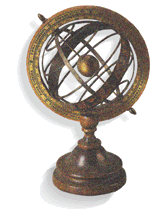 Request copies by calling 1.866.444.3272
Request copies by calling 1.866.444.3272
The Social Security Administration Website has online resources to help calculate your retirement benefits and to learn about survivor benefits and Medicare. Two publications you may want to view or order: Understanding the Benefits and What Every Woman Should Know.
AARP offers a wealth of information, including a fact sheet on reverse mortgages and a retirement income calculator. Phone: 1.888.OUR.AARP (1.888.687.2277).
For those employees who may have worked for a company with a traditional defined benefit (DB) pension, the Pension Benefit Guaranty Corporation can assist in locating any money still in your account. Those with DB plans will also find these two publications useful: Your Guaranteed Pension and Finding a Lost Pension, Tel. 1.800.400.7242.
Browse the Website of the National Endowment for Financial Education for a wealth of pre-retirement information.
 Saving And Investing
Saving And Investing
In addition to consumer fact sheets and studies, the Consumer Federation of America's Website offers a free savings brochure, 6 Steps to Six-Figure Savings, Tel. 202.387.6121.
The Securities and Exchange Commission Website offers a menu of online Investor Information topics for consumer reference. View Invest Wisely: An Introduction to Mutual Funds and dozens of other titles.
MyMoney.gov is a Website sponsored by the Financial Literacy and Education Commission, U.S. Department of the Treasury, and has among its offerings the My Money Tool Kit.
The Internal Revenue Service's Individual Retirement Arrangements is one of several guides to retirement plans that the agency offers.
The Federal Citizen Information Center Website is your portal to government information, from car insurance to retirement savings. You can also view or order a free copy of the Consumer Information Catalog at this site.
A recent addition to the Internet, sponsored by the American Institute of Certified Public Accountants is 360 Degrees of Financial Literacy. The Web pages view finances throughout life - from childhood, to college, career, and retirement and estate planning.
 Getting Help
Getting Help
North American Securities Administrators Association's site alerts readers to the latest money scams and to any disciplinary rulings against individual financial advisers. The Website also includes a section on investor education, including this publication: Protecting Your Finances: How to Avoid Investment Frauds and Scams.
The Certified Financial Planner Board of Standards Website lets you look up a certified financial planner near you. The organization also distributes a free Financial Planning Resource Kit. Tel. 1.800.487.1497.
The National Association of Personal Financial Advisors is an organization of fee-only comprehensive financial professionals. The Website also includes retirement planning information. Tel. 1.800.366.2732.
On The Actuarial Foundation's Website, view the following publications:
- Seven Life-Defining Financial Decisions
- Making Your Money Last for a Lifetime: Why You Need to Know About Annuities
- Don't Run with Your Retirement Money.
The Society of Actuaries Website (see News and Publications links to informative articles in the group's publication, The Actuary Magazine.
The Federal Trade Commission's site includes over two dozen fact sheets and brochures warning consumers about scam investments. View Reverse Mortgages: Get the Facts before Cashing in On Your Home's Equity and others.
Topics from money to housing are included at the Administration on Aging Elders and Families site.
 The Centers for Medicare and Medicaid Services and the Medicare sites of the U.S. Department of Health and Human Services are your first and most reliable resource for information on Medicare. They include information on billing, appeals, long-term care, and links to information on Medigap policies and the new prescription drug program. Start with these publications:
The Centers for Medicare and Medicaid Services and the Medicare sites of the U.S. Department of Health and Human Services are your first and most reliable resource for information on Medicare. They include information on billing, appeals, long-term care, and links to information on Medigap policies and the new prescription drug program. Start with these publications:
- Medicare and You
- Choosing a Medigap Policy: A Guide to Health Insurance for People with Medicare
- Your Guide to Medicare Prescription Drug Coverage.
The Social Security Administration also has information on the Medicare Prescription Drug Program.
The U.S. Department of Health and Human Services has developed a National Clearinghouse for Long-Term Care Information.

 This publication has been developed by the U.S. Department of Labor, Employee Benefits Security Administration, and its partners. We also thank the AARP for its valuable contributions to this publication. For a complete list of EBSA publications or to speak with a benefits advisor, call toll free: 1.866.444.3272. Or contact the agency electronically at www.askebsa.dol.gov. This booklet constitutes a small entity compliance guide for purposes of the Small Business Regulatory Enforcement Act of 1996.
This publication has been developed by the U.S. Department of Labor, Employee Benefits Security Administration, and its partners. We also thank the AARP for its valuable contributions to this publication. For a complete list of EBSA publications or to speak with a benefits advisor, call toll free: 1.866.444.3272. Or contact the agency electronically at www.askebsa.dol.gov. This booklet constitutes a small entity compliance guide for purposes of the Small Business Regulatory Enforcement Act of 1996.